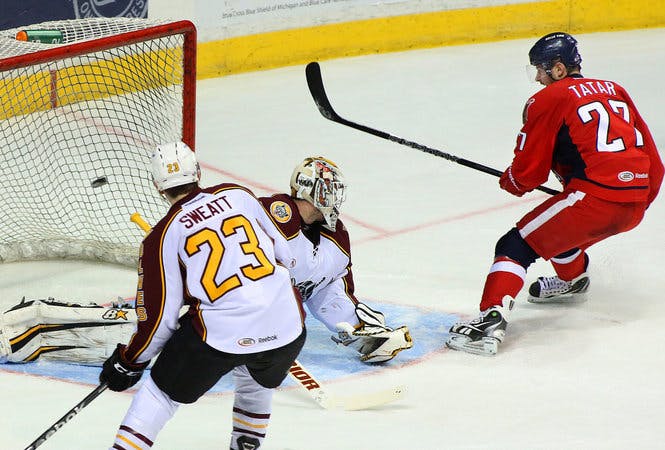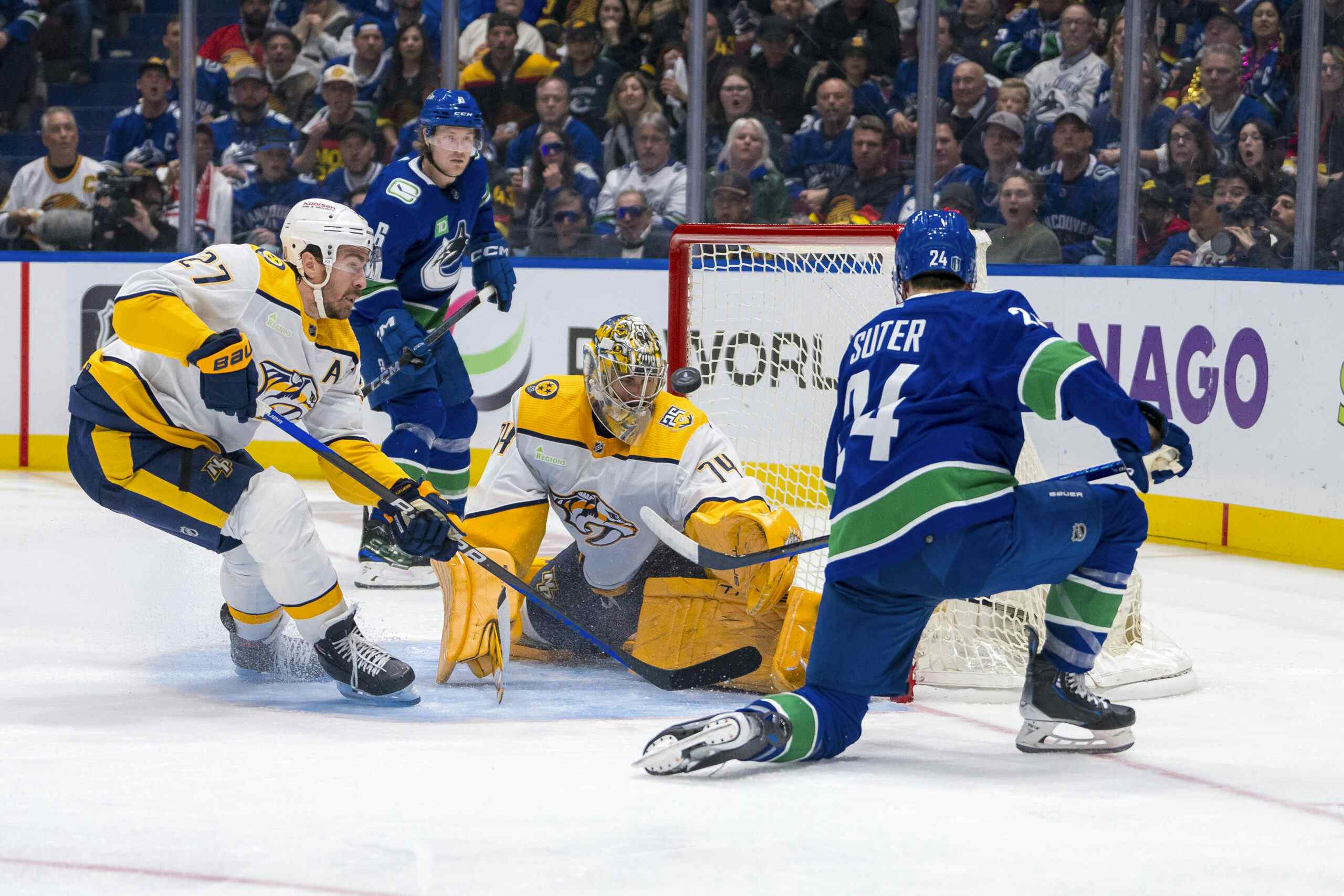Chicago Wolves Quality of Competition, and the End of their Affiliation with the Canucks

Bill Sweatt gets burned by Tomas Tatar who qualifies as tough competition.
Photograph by Rex Larsen
Earlier this week the Chicago Wolves signed an affiliation agreement with the St. Louis Blues, the organization the Canucks had previously acquired the Peoria Rivermen from.
So the affiliation agreement between the Canucks and the Chicago Wolves has ended after two years, and while I wouldn’t go so far as to say that the relationship has ended on an acrimonious note publicly, I would suggest that it seems the two sides are glad to be moving on.
Read past the jump.
For example, Chicago Wolves President of Business Development Mike Gordon told ChicagoBusiness.com earlier this week that one of the reasons the relationship didn’t seem to have "long-term potential" is that "[The Canucks’ goal] is to develop players into NHL players, our goal is to win," and that having, "someone else control some of the moves (we make) doesn’t work well in this market with our owner." Well if that doesn’t confirm pretty much every complaint about the Chicago Wolves not doing enough to develop Canucks prospects, I’m not sure what will.
Meanwhile Mike Gillis, in discussing the advantages of outright ownership of an AHL franchise on the Team 1040 yesterday, had this to say:
"When you do an affiliation agreement with an independent operator they do control the roster, and they do control elements of the roster. And they’re free to go out and sign their own players to some extent, we have limited opportunity to guide them in that area. So, you know, they may go out and sign three defenceman who are senior American League defenceman and that leaves young players not getting developed."
Do you think Mike Gillis is discussing the lieks of Mark Matheson, Brad Hunt and Jeremie Blain or Danny Groulx when he singles out three "senior American League defenceman"? I’m not sure, really, but it certainly seems possible.
Parting shots aside, hockey statistics recorded and made public by the AHL aren’t very detailed. We don’t even have time-on-ice data, so it’s pretty tough to figure out how Canucks prospects are being used and deployed at the American Hockey League level. As a way of working around that, I tapped my buddy Rob Pettapiece to replicate our friend Scott Reynolds’s work on Quality of Competition estimates for the American Hockey League. Here’s the methodology:
Methodology: To measure quality of competition, I simply looked through the boxscores and identified all of the opposition forwards on the ice for every goal scored both for and against while a player was on the ice at even strength (excluding empty net situations). For quality of teammates, it’s the same process, but I’m identifying the forwards on the player’s team rather than his opponents. The final "quality of competition" number is the average points per game of the opposing forwards when a given player is on the ice, and the final "quality of teammates" number is the average points per game of that player’s forward teammates. For example, a player with a "quality of competition" score of 0.500 would be facing forwards who, on average, have scored 0.500 points per game in the AHL during the 2010-11 season. I like the method because the final number should be pretty understandable.
So the major difference between the AHL estimate numbers that Rob has put together, and the Quality of Competition (or even Corsi-Rel QoC numbers) that you can find at BehindTheNet.ca, is that the NHL data is based on shots, while Rob’s data relies solely on goals. As a result of our QoC estimate numbers using a smaller sample of events (there are more shots to count up than goals, obviously), the NHL data is unsurprisingly way more precise. The more sophisticated NHL level statistics also allows for more separation between a sheltered fourth liner, and a tough minutes "strength-on-strength" two-way ace; but still, the data Rob has put together gives us a pretty good estimate of which players were doing the heavy lifting in Chicago this past season.
So let’s take a look at the Quality of Competition estimates for Wolves forwards this past season. For context, the league average for quality of competition was 0.266, while the average quality of competition for the Wolves slots in a bit higher than that at 0.276. I’ve included only those Wolves forwards who were on the ice for at least 10 goal events, but remember that the larger the GF/GA ON sample, the more accurate we can assume these numbers are.
| Wolves Forwards | GF/GAON | QualComp | QualTeam |
|---|---|---|---|
| Nicklas Jensen | 12 | 0.308 | 0.227 |
| Eric Kattelus | 27 | 0.294 | 0.273 |
| Tim Miller | 31 | 0.293 | 0.247 |
| Andrew Gordon | 59 | 0.290 | 0.326 |
| Darren Haydar | 93 | 0.287 | 0.304 |
| Brett Sterling | 59 | 0.287 | 0.315 |
| Bill Sweatt | 60 | 0.280 | 0.297 |
| Nathan Longpre | 50 | 0.277 | 0.277 |
| Stefan Schneider | 17 | 0.274 | 0.222 |
| Darren Archibald | 43 | 0.272 | 0.285 |
| Jordan Schroeder | 52 | 0.268 | 0.283 |
| Zack Kassian | 34 | 0.266 | 0.314 |
| Andrew Ebbett | 37 | 0.266 | 0.340 |
| Guillaume Desbiens | 27 | 0.265 | 0.218 |
| Michael Davies | 41 | 0.263 | 0.237 |
| Alex Friesen | 26 | 0.262 | 0.260 |
| Steve Pinizzotto | 30 | 0.261 | 0.280 |
| Anton Rodin | 35 | 0.259 | 0.278 |
| Devin DiDiomete | 11 | 0.200 | 0.220 |
On the one hand it appears that AHL veterans like Darren Haydar, Andrew Gordon (who is at least Canucks property) and Brett Sterling did do the heavy lifting for the Wolves this season. Among Canucks prospects who battled above average competition over a large sample were Bill Sweatt, Darren Archibald and Jordan Schroeder, which I think helps add some context to their performance this year.
For example, Andrew Ebbett played with more skilled linemates in the American Hockey League this season than did Jordan Schroeder, while battling slightly lesser competition. Just wanted to mention that for those who remain convinced of the inexplicable notion that Andrew Ebbett is a superior option for the Canucks at centre than Schoreder is based on Ebbett’s AHL production over a thirty game sample this season.
During his time in the AHL in the fall Zack Kassian battled average competition and skated with qualtiy line-mates. It’s a little bit troubling then that he didn’t produce at a similar rate in the American Hockey League as he did a season ago in Rochester. As for Nicklas Jensen who disappointed in his AHL stint this season after lighting up the SEL as a 19 year old rookie, it appears he faced tough competition while skating with significantly less skilled line-mates. While that would be a relief for Canucks fan prospectophiles, the fact is we shouldn’t really make much of anything out of a 12 goal sample…
Finally the Canucks prospects who were "sheltered" include pint-sized centre Alex Friesen and the disappointing Anton Rodin. Friesen has been billed as a "defensive centre" so hopefully we see him battle tougher competition next season, while Anton Rodin has really no excuse for his disappointing offensive production this season. There have been whispers that Rodin has worn out his welcome in the Canucks organization, and after struggling to produce while battling the weakest competition among regular Wolves forwards for a second straight year, it’s not hard to understand why.
Let’s move onto Qual Comp numbers for Wolves defenceman. Again we’ll only include those players who have a goal events sample above ten:
| Wolves Defenseman | GF/GA ON | QualComp | QualTeam |
|---|---|---|---|
| Danny Groulx | 18 | 0.306 | 0.305 |
| Jeremie Blain | 26 | 0.295 | 0.307 |
| Jim Vandermeer | 38 | 0.291 | 0.275 |
| Chris Tanev | 39 | 0.282 | 0.35 |
| Peter Andersson | 32 | 0.281 | 0.28 |
| Derek Joslin | 58 | 0.278 | 0.306 |
| Mark Matheson | 80 | 0.271 | 0.315 |
| Yann Sauve | 25 | 0.271 | 0.317 |
| Adam Polasek | 20 | 0.269 | 0.31 |
| Kevin Connauton | 79 | 0.268 | 0.321 |
| Zach Miskovic | 17 | 0.264 | 0.349 |
| Brad Hunt | 65 | 0.256 | 0.318 |
So the list of Canucks prospects who played against above average competition by Wolves standards were Chris Tanev and Peter Andersson. Every other Wolves defenseman played against above average competition by leaguewide standards except for Zach Miskoivc and Brad Hunt.
I suppose it’s worth pointing out that Kevin Connauton faced the weakest competition among all regular Wolves blueliners, which I’d presume probably plays into him being deemed "expendable" by the organization.
Yann Sauve and Adam Polasek didn’t play much, spent time in the ECHL this season, and appear to have been mostly third pairing guys. I’d imagine that has to be frustrating for the Canucks when guys like Brad Hunt, Zach Miskovic, Jeremie Blain and Danny Groulx were soaking up lots of blue-line minutes. On the other hand, neither Sauve nor Polasek really projects as a future NHLer at this point anyway.
With Connauton traded, Tanev having graduated to the NHL roster, and Corrado likely to compete for an NHL spot next season (according to Mike GIllis), it appears possible that Peter Andersson could be Vancouver’s best backend prospect at the AHL level a year from now. Andersson has improved enormously over the course of a couple of seasons, but I still don’t really see him as an NHL player unless his skating stride takes a quantum leap forward over the next year or two. Andersson’s main competition on that front will probably be Jeremy Price, who in too small a sample of goal events to be included in the above table, faced the toughest competition among all Wolves players in his five games this season (again take that small sample nugget of information with an entire shaker worth of salt).
Overall this analysis suggests that Chicago’s AHL veterans did the bulk of the heavy lifting for this Wolves this past season. I’ll be very curious to go through the data again next year, and see if there’s any change in deployment and the parcelling out of defensive responsibilities by an AHL club that the Canucks own outright.
Recent articles from Thomas Drance





